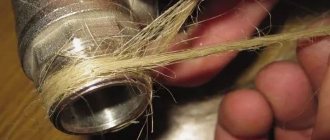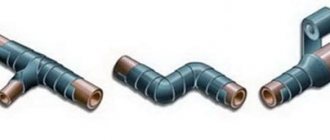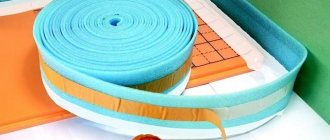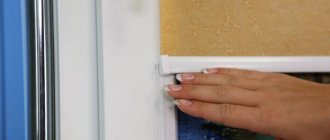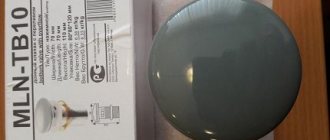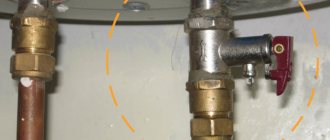What is fum tape
The tape is a thin narrow film, for the production of which fluoroplastic is used. The prefix “fum” stands for fluoroplastic sealing material. The plumbing option is available in two types:
- in white color with large thickness values;
- translucent film in a minimum thickness range.
Regardless of the type, the fumka has the following properties:
- elasticity;
- heat resistance;
- inertness to chemicals;
- elongation at break – not less than 200%;
- thickness indicator – 0.075-0.2 mm;
- the average value of tensile strength is 1.5 MPa.
The product manufacturing process involves using the method of rolling a fluoroplastic rope and then winding it onto polypropylene bobbins that come with the lid. To prevent the layers from sticking together when winding, one side of the material is coated with lubricant. Vaseline oil is most often used. In stores you can find fumka without lubrication.
The average tape width is 10-60 mm.
What is fum tape used for?
Fum tape is a sealing material made from fluoroplastic sealant. Often, fum looks like a translucent or white material with a matte surface. Its advantages are high levels of resistance to thermal and mechanical damage.
Over time, the product does not lose its properties, does not suffer from deformation or rupture, and also does not react to various materials when in an aggressive (chemical) environment.
The use of fum tape is quite diverse: with its help, a tight seal is created at the connection of a flange, nipple or threaded pipeline. This material is also used in engineering environments where pressure indicators are no higher than 9.8 MPa.
In the manufacture of fum tape, a polymer material called “fluoroplastic-4” is used. The finished material can be rolled out into a roll whose width is up to 16 millimeters, after which it goes to the packaging department. Depending on the manufacturer, fum tape may also have an adhesive layer or lubricating materials.
Proper Use
To wind the tape correctly, you do not need to have any special skills. At the same time, it is extremely important to know about the subtleties and nuances that help in working with this material.
Before you start using the material, it is extremely important to perform a number of procedures:
It is worth noting that the fum tape should be wound clockwise, which will help avoid tearing the tape while connecting the elements. When applying the tape, you need to create a slight tension to achieve the desired level of winding density.
It is worth remembering that a stretched tape will give the connection not only tightness, but also strength. When applying the tape, it is advisable not to overdo it with tension, because it may not withstand it. It is prohibited to wind fum tape in pieces.
For example, in order to seal a pipe whose diameter is 30 millimeters, it is recommended to wind three layers of tape. However, for pipes whose diameter is 40 millimeters, it is already worth winding four layers of fum tape.
For water
FUM for thread sealing is a tape in a reel. The tape from different manufacturers differs in width (from 10 to 60 mm) and thickness (0.075 mm, 0.12 mm, 01 or 0.2 mm). The model is selected individually, it all depends on the diameter of the thread and - what is important - the experience of the master.
When choosing FUM sanitary tape, it is important to find out how well it stretches. Poor quality material is easy to determine - at the first pull the tape will break. But this again requires experience - to know which manufacturer does not skimp on quality - or trial and error.
Disadvantages of fum: Uneconomical consumption.
To understand what width and thickness of tape to choose for carving and how many turns to make, you need practice. It will not be possible to determine it “by eye” the first time.
For one high-quality connection on the FUM, you will have to make several “idle” ones, and before that, buy different tapes and try each one. The number of turns, depending on the thread size, ranges from 5 to 20 or more.
Tape for water pipe joints is considered one of the cheapest sealants. The price for a reel starts from 9-12 rubles. And it ends in different ways - 99, 120, and 170 rubles. Considering the consumption of FUM and the need for training on a single thread, there is no talk of saving. In terms of the cost of one connection, FUM is almost equal to plumbing thread.
For gas
Fluoroplastic sealing material, intended for sealing threaded and flanged connections made of all materials operating both in general industrial environments and in aggressive environments, is a non-sintered fluoroplastic film.
Produced in skeins of 10 meters, 0.1 mm thick, 12 mm wide.
It can also be used for water and heating. Fluoroplastic retains its strength over a wide temperature range and is inert to aggressive environments. Fum tape is universal, convenient and prevents the connection from “souring”, which makes dismantling easier.
- Let's look at the characteristics of one of the fum tapes:
What is it used for?
The sealant is most often used in everyday life when installing a pipeline that operates under pressure. This includes gas and water supply, central heating systems. Due to its high performance characteristics, the material is used when carrying out repair work on cars and household appliances.
Fum tape is considered a universal material, so it is used in various fields and industries.
PTFE sealant is recommended for the following connections:
- nipple;
- threaded;
- flanged.
In what cases can you use tape:
- when installing a short-length water pipeline;
- sealing the joint area on plastic pipes;
- installation of water supply elements with fine threads;
- replacing rings or gaskets on the tap;
- temporary fixation of parts in case of water breakthrough;
- connection to the system of plumbing devices of a simple design.
In other cases, it is advisable to use plumbing thread. For gas networks, it is recommended to use a special certified tape.
PTFE insulation is recommended for pipelines in which the pressure does not exceed 9.8 MPa. In other cases, it is necessary to use alternative options.
Three types of plumbing seal:
| Brand | Peculiarity | Application area |
| FUM-1 | has a lubricant in the form of petroleum jelly | used in plumbing work on industrial and domestic highways |
| FUM-2 | no lubricant | the product is recommended for objects interacting with oxidizing agents and oxygen |
| FUM-3 | narrow strips, which are cuts of two types of tapes (fum-1 and fum-2) | main purpose – household highways |
Kinds
Fum tape is classified into the following main groups, depending on its purpose:
- Fum-1. Used for sealing gas and water supply networks, in systems with aggressive chemicals. Lubricant is used (up to 20% petroleum jelly).
- Fum-2. As a sealant for systems in which strong oxidizing agents and oxygen circulate. No lubricant is used.
- Fum-3. Used for water and gas systems, including systems with aggressive substances. No lubricant is used. Typically, this type of fum tape is used as the edge part of the tapes listed above.
Performance characteristics
The popularity of sanitary ware is due to the high performance characteristics of the material and physical properties.
| Friction coefficient | short |
| Availability of lubrication, % | 0,3-20 |
| Elongation at break, % (ductility) | 100-200 |
| Maximum tensile stress, kg/cm2 | 40-60 |
| Strength range, MPa | 10-41,2 |
| Heat resistance, °C | more than 300 |
| Resistance to aggressive chemical environments | high, there are no solvents for fluoroplastic tape |
| Average service life | 13 years |
It is difficult for a beginner to understand the intricacies and features of fum tape. Therefore, it is better to consult with an experienced plumber regarding the use of the material.
Advantages of the seal:
- a quick way to create a tight connection between parts of a pipeline;
- ready for use, no pre-treatment required;
- due to its elasticity and strength, the material fits tightly onto the thread;
- long operational period;
- the ability to tighten the connection by rotating 180 degrees;
- there are no difficulties during dismantling, the tape only needs to be untwisted;
- affordable price;
- selection of parameters (thickness, width, density) suitable for a certain pipe diameter.
Considering the film’s resistance to low temperatures, the foam can be used in open systems located outdoors.
Flaws:
- the surface of the thread must be dried to avoid the tape slipping;
- low aesthetics due to the protruding ends of the seal;
- when tightening, the fum tape can move out or be pulled into the internal cavity of the pipe.
Working with the sealant is easy, but there are still some nuances. If you are careless while winding onto the thread, the tape can easily be broken by sharp and protruding elements of the pipeline.
Taking into account the properties of fluoroplastic film, experts do not recommend using it when installing a pipeline of complex engineering design.
What temperature can fum tape withstand?
The operating temperature range of the plumbing tape is wide – from -70 to +200 degrees Celsius. Going beyond the designated boundaries is fraught with loss of properties of this material. When the reading is above 260°, the seal begins to release toxic substances. At a temperature of +560° it ignites.
Fum tape can be used to seal connections in hot water supply pipelines, heating pipes and other systems where the coolant/water temperature does not exceed the designated operating temperature limits.
Properties and technical characteristics of fum tape
When using this product when carrying out plumbing work, it is useful to learn about the main properties, characteristics, pros and cons.
Fum tape: technical characteristics
Plumbing tape has a fairly low level of friction, it is elastic, slides and stretches. This makes it easy to seal various connections. It provides a good fit and seal.
Fumlenta has high heat resistance (resistance to temperature changes). This is an important property of the material, which allows it to withstand high temperatures, more than 300 C. But it should be noted that when heated above 250 degrees, the tape material begins to release toxic harmful substances.
It has high ductility and tensile strength. FUM plumbing tape is very durable and practically not subject to rotting.
It has great resistance to chemicals, acids, and alkalis.
These tapes can even serve to insulate electricity.
How to wind on a thread correctly
Before using the tape, you need to carefully prepare the surface:
- clean the thread from dirt, remove rust;
- degrease the cleaned area (you can use gasoline or paint thinner);
- dry the thread with a dry cloth (or let it dry naturally).
If you do not have the skills to work with fluoroplastic sealant, it is recommended that you familiarize yourself with the advice of experienced craftsmen.
There is no exact information on how many layers of sealant to screw onto the threads. For small diameter pipes, 4-6 layers are sufficient. For thick conductors, 20-25 turns may be required.
When working with pipes with a diameter of 30-40 mm, it is recommended to wind 4 layers of tape.
The seal is wound clockwise or in the direction of movement of the pipe screwed onto the thread. If the direction is violated, the tape will curl and will not perform its functions.
When working with fittings from 1 inch, you need to wind the tape over its entire width so that its surface is pressed between the turns.
Winding the tape onto a wide thread is done in two stages. First, each turn is filled with a bundle twisted from tape. Then there is a layer-by-layer coating of the entire width with film.
If the thread breaks during winding, you should remove the wound part and do the job again. If you wind the thread in pieces, the connection will not be tight.
The sealant must not be reused. If folds or breaks occur during winding, the damaged fragment is disposed of.
Winding process:
- Place the edge of the film on the fold, guide the tape in the direction of the thread clockwise;
- when creating a new turn, adjust the seal, slightly tightening the bobbin;
- there is no need to stretch the material excessively, it should just lie tightly to the base;
- the edge of the tape should not extend onto the inner diameter of the pipe;
- layer by layer the thread zone is overlapped, the end is pressed tightly to the base so that the film does not create obstacles when screwing in the elements;
- To create an even cut, use a tool with a sharp blade (you cannot cut it off!).
Winding is carried out until the thread relief is hidden under the layers of sealant.
How much fum tape to wind on the thread
There is no definite answer to this question, since the number of turns and the thickness of the layer of fluoroplastic tape sealant is determined exclusively experimentally. Below are some recommendations:
- The tape is wound until the entire surface of the thread is hidden. The surface must be flat, and the protrusions must be visible through the sealant layer;
- The number of turns is directly related to the diameter of the threaded connection and the depth of the thread, since to ensure tightness it is necessary to fill the gaps between the groove and the protrusion of the thread;
- Approximately, for pipes with a diameter of 10 to 25 mm, 7-10 turns are wound, from 25 to 40 mm, 13-15 layers of fum tape will be required.
- In addition to the design dimensions, the condition of the thread, the degree of wear, and the presence of mechanical and erosion damage should be taken into account.
What can be used instead of fum tape
If you don’t have fum tape on hand when making pipeline connections, you can use alternative options.
Tow with paste
Tow is a flax fiber. They may be scratchy and matted. To create a hermetic connection, flax was previously coated with red lead or oil paint. Nowadays tow is combined with plumbing sealing paste.
Linen seal has the following advantages:
- suitable for pipes of different diameters;
- forms a strong connection without requiring preliminary drying of the threaded surface;
- You can purchase it at an affordable price.
The disadvantage is the susceptibility of natural fibers to microbiological processes. Installation requires additional tightening of the threads, since water leakage may occur when the material shrinks.
To eliminate nuances, craftsmen apply a sealing paste to the tow, which prevents the flax from rotting and drying out.
Sealing thread
The thread is made from natural and polymer raw materials. The universal sealant is applied in a cross-shaped manner to the threads. A distinctive feature is the ability to adjust the connection with a scroll up to 180 degrees.
The advantages include:
- speed and ease of winding;
- safety and reliability;
- versatility (suitable for gas and water pipes);
- resistance to vibrations and mechanical stress.
The disadvantages include low efficiency when used on smooth and canonical threads. The material simply slides off the surface.
Anaerobic adhesive sealant
This is an innovative way to seal threads in pipeline elements. The composition is made from polymer materials characterized by high resistance to microbiological processes and mechanical stress.
Advantages of sealant:
- readiness for use;
- convenient use, just unscrew the tube cap and apply the gel to the thread;
- equipped with a brush that removes excess composition;
- inertness to corrosion processes;
- easy removal after disconnecting the pipeline elements (after unscrewing the thread, the glue turns into powder).
The material is not without its shortcomings. Among the significant disadvantages is the unwinding of the threaded connection sealed with sealant. After installation, a strong fixation of the pipeline elements is formed. For promotion you will need to use a special tool. As an option, heat the surface at the joint.
All of the listed seals, when used correctly, provide high-quality sealing of connections of pipeline elements.
Which is better linen or fum tape
Previously, flax fibers were used to seal plumbing connections. The natural material can be screwed over wet threads and can withstand mechanical loads well. A high degree of sealing is ensured by the process of flax swelling under the influence of water.
When carrying out repair work, the winding can be replaced without much difficulty. Despite its significant advantages, flax has low resistance to microbiological processes. In a humid environment, the structure slowly deteriorates.
Deciding on the choice between flax and fum tape is not difficult if you know the area of application of the material. For example, to connect large diameter pipes or create a tight connection between a fitting and a pipe, experts advise using flax fibers. It is better to connect the flexible hose to the mixer using tape.
What is the difference between fum tape for water and gas?
At first glance, fum tapes for gas and plumbing work seem the same. In fact, there are differences between them.
| Criteria | For gas | For water |
| Color | yellow | white |
| Thickness, mm | 0,15-0,25 | 0,075-0,25 |
| Width, cm | 1,5-2,0 | 1,0-10 |
| Density | higher | below |
The cost of materials does not differ significantly, but you will have to pay a little more for the gas tape. It is also subject to special quality requirements and must have a certificate of conformity.
